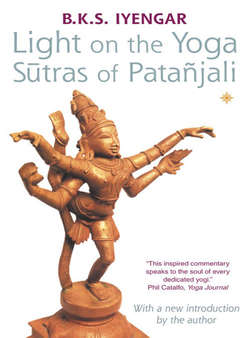Читать книгу Light on the Yoga Sutras of Patanjali - Литагент HarperCollins USD - Страница 11
Sadhana Pada
ОглавлениеIn the second chapter, sadhana pada, Patañjali comes down to the level of the spiritually unevolved to help them, too, to aspire to absolute freedom. Here he coins the word kriyayoga. Kriya means action, and kriyayoga emphasizes the dynamic effort to be made by the sadhaka. It is composed of eight yogic disciplines, yama and niyama, Asana and pranayama, pratyahara and dharana, dhyana and samadhi. These are compressed into three tiers. The tier formed by the first two pairs, yama and niyama, Asana and pranayama, comes under tapas (religious spirit in practice). The second tier, pratyahara and dharana, is self-study (svadhyaya). The third, dhyana and samadhi, is Isvara pranidhana, the surrender of the individual self to the Universal Spirit, or God (Isvara).
In this way, Patañjali covers the three great paths of Indian philosophy in the Yoga Sutras. Karmamarga, the path of action is contained in tapas; jñanamarga, the path of knowledge, in svadhyaya; and bhaktimarga, the path of surrender to God, in Isvara pranidhana.
In this chapter, Patañjali identifies avidya, spiritual ignorance, as the source of all sorrow and unhappiness. Avidya is the first of the five klesas, or afflictions, and is the root of all the others: egoism, attachment, aversion and clinging to life. From these arise desires, sowing the seeds of sorrow.
Afflictions are of three types. They may be self-inflicted, hereditary, or caused through imbalance of elements in the body. All are consequences of one’s actions, in this or previous lifetimes, and are to be overcome through practice and renunciation in the eight yogic disciplines which cover purification of the body, senses and mind, an intense discipline whereby the seeds are incinerated, impurities vanish, and the seeker reaches a state of serenity in which he merges with the seer.
For one who lacks ethical discipline and perfect physical health, there can be no spiritual illumination. Body, mind and spirit are inseparable: if the body is asleep, the soul is asleep.
The seeker is taught to perform Asanas so that he becomes familiar with his body, senses and intelligence. He develops alertness, sensitivity, and the power of concentration. pranayama gives control over the subtle qualities of the elements – sound, touch, shape, taste and smell. Pratyahara is the withdrawal into the mind of the organs of action and senses of perception.
Sadhana pada ends here, but Patañjali extends dharana, dhyana and samadhi, the subtle aspects of sadhana, into the next chapter, vibhuti pada. These three withdraw the mind into the consciousness, and the consciousness into the soul.
The journey from yama to pratyahara, described in sadhana pada, ends in the sea of tranquillity, which has no ripples. If citta is the sea, its movements (vrttis) are the ripples. Body, mind and consciousness are in communion with the soul; they are now free from attachments and aversions, memories of place and time. The impurities of body and mind are cleansed, the dawning light of wisdom vanquishes ignorance, innocence replaces arrogance and pride, and the seeker becomes the seer.
